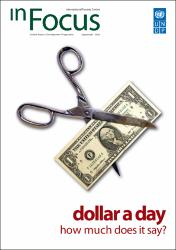Please use this identifier to cite or link to this item:
https://repositorio.ipea.gov.br/handle/11058/15266Full metadata record
| DC Field | Value | Language |
|---|---|---|
| dc.contributor.author | Grinspun, Alejandro | |
| dc.date.accessioned | 2024-10-03T23:53:32Z | - |
| dc.date.available | 2024-10-03T23:53:32Z | - |
| dc.date.issued | 2004 | |
| dc.identifier.uri | https://repositorio.ipea.gov.br/handle/11058/15266 | - |
| dc.description.abstract | "'The poor’, wrote Charles Booth in 1889, are those ‘whose means are barely sufficient for decent independent life… according to the usual standard of life in this country’. In his Life and Labour of the London Poor, Booth defined a ‘line of poverty’ of 21 shillings per week below which an average family would be ‘living under a struggle to obtain the necessaries of life and make both ends meet’. Shortly after Booth’s work, another Englishman, Seebhom Rowntree, published a famous study of poverty in York that helped popularize the term ‘poverty line’ which, in Rowntree’s view, represented ‘a standard of bare subsistence rather than living’. Clearly, the idea of a welfare threshold expressed in monetary terms has a long pedigree. Particularly since the 1960s, a growing number of countries began to adopt national poverty lines — sometimes defined in relative terms, as in most industrialized countries, but more often as absolute thresholds that typically refer to a bundle of commodities to satisfy minimum basic needs. Because of differences in standards of living, data availability and survey definitions, comparing poverty rates across countries or aggregating them into regional and world totals proved elusive for many years. This also precluded assessing overall trends in poverty, which had to rely on evidence from individual countries or groups of countries. Then, in 1990, the World Bank proposed a common international poverty threshold of one dollar per day, in 1985 purchasing power parity prices. The ‘$1-a-day’ poverty line immediately grabbed much attention and gained further acceptance in recent years, when the UN Millennium Summit adopted it as the benchmark for monitoring progress in reducing extreme poverty around the world." (...) | en |
| dc.language.iso | en | |
| dc.title | Dollar a day - how much does it say? | en |
| dc.type | Policy In Focus | |
| dc.rights.holder | International Policy Centre for Inclusive Growth | |
| dc.rights.holder | United Nations Development Programme | |
| dc.location.country | Brasil | |
| dc.description.physical | 16 p. : il. | |
| dc.rights.type | Licença total exclusiva | |
| dc.rights.license | O texto e dados desta publicação podem ser reproduzidos desde que as fontes sejam citadas. Reproduções com fins comerciais são proibidas. | |
| dc.subject.keyword | Dollar | |
| ipea.access.type | Acesso Aberto | |
| ipea.researchfields | N/A | |
| ipea.classification | Demografia. População | |
| ipea.classification | Economia. Desenvolvimento Econômico | |
| Appears in Collections: | Publicações do IPC-IG | |
Files in This Item:
| File | Description | Size | Format | |
|---|---|---|---|---|
| en_IPCPovertyInFocus4.pdf | 254.17 kB | Adobe PDF |  View/Open |
Items in DSpace are protected by copyright, with all rights reserved, unless otherwise indicated.

